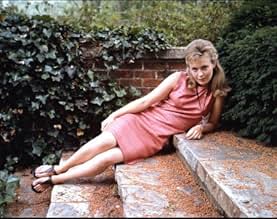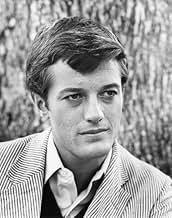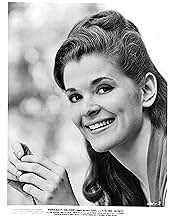NOTE IMDb
6,8/10
3,5 k
MA NOTE
Un ancien combattant trouve du travail dans une institution psychiatrique où il rencontre la belle, mais excentrique Lilith.Un ancien combattant trouve du travail dans une institution psychiatrique où il rencontre la belle, mais excentrique Lilith.Un ancien combattant trouve du travail dans une institution psychiatrique où il rencontre la belle, mais excentrique Lilith.
- Réalisation
- Scénario
- Casting principal
- Récompenses
- 2 nominations au total
Walter Arnold
- Lonely Girl's Father
- (non crédité)
Rene Auberjonois
- Howie
- (non crédité)
Elizabeth Bader
- Girl at Bar
- (non crédité)
Ruth Baker
- Patient
- (non crédité)
Janet Banzet
- Patient
- (non crédité)
Amelie Barleon
- Patient
- (non crédité)
Carson Barnes
- Child Crossing Street
- (non crédité)
Jeanne Barr
- Miss Glassman
- (non crédité)
David Barry
- Ambulance Attendant
- (non crédité)
Avis à la une
This film was referred to me by a classmate at the U.S. Navy school I was attending in mid-1965. I was a naive young sailor who invariably felt like I didn't fit in. I had felt very connected with James Dean, specifically in REBEL WITHOUT a CAUSE -- talk about a misunderstood young man! Being a bit disturbed seemed to work with both James and myself when attracting kind-hearted and trusting young women.
That being said, and having no idea what the movie was about, I paid my dime (at the base theater), entered, visited the snack bar and proceeded to have my whole world altered. Warren Beatty a kindred spirit -- honest, compassionate, trusting and vulnerable, with a few secrets of his own best kept buried deep within. Jean Seaberg was a vision of desire, sensuality, and intrigue, with more than enough dark secrets herself to draw me and Warren into her world like the largest, strongest magnet on Earth. Before long the co-stars were as one in Lilith's playground. I quickly followed eagerly -- her world looked far better than any I had ever seen or imagined. I was lead on a fabulous, ALICE IN WONDERLAND journey where, while much was familiar, I wasn't at all sure which way was up.
As the movie ended I still had no sense of direction. Hoping to gain greater understanding of where I had ended up and how to return to the "real" world, although I was not entirely sure I wanted to, I exited the theater, paid another dime and returned to my still-warm seat.
No answer was forthcoming -- only more questions, as I re-entered Lilith's wonderland. I think I have never left, nor do I have even the slightest desire to.
That being said, and having no idea what the movie was about, I paid my dime (at the base theater), entered, visited the snack bar and proceeded to have my whole world altered. Warren Beatty a kindred spirit -- honest, compassionate, trusting and vulnerable, with a few secrets of his own best kept buried deep within. Jean Seaberg was a vision of desire, sensuality, and intrigue, with more than enough dark secrets herself to draw me and Warren into her world like the largest, strongest magnet on Earth. Before long the co-stars were as one in Lilith's playground. I quickly followed eagerly -- her world looked far better than any I had ever seen or imagined. I was lead on a fabulous, ALICE IN WONDERLAND journey where, while much was familiar, I wasn't at all sure which way was up.
As the movie ended I still had no sense of direction. Hoping to gain greater understanding of where I had ended up and how to return to the "real" world, although I was not entirely sure I wanted to, I exited the theater, paid another dime and returned to my still-warm seat.
No answer was forthcoming -- only more questions, as I re-entered Lilith's wonderland. I think I have never left, nor do I have even the slightest desire to.
Jean Seberg was a woefully inadequate actress in almost every role in which she was cast but she seemed born to play Lilith, the unstable, deeply amoral 'heroine' of Robert Rossen's last film. It's an extraordinary performance and it's extraordinary because it doesn't appear to have anything to do with 'acting'; it just seems to exist. The theme of the film is madness, not 'mental illness' but madness in the truly Shakespearean sense of the word, and everything about the film is heightened, a little unreal. Eugen Schufftan photographs the film in a hazy monochrome with the emphasis on white. We peer at the characters through shafts of sunlight, (and there is a lot of water on view, too).
And Seberg isn't the only extraordinary performance. There is excellent work, too, from Warren Beatty as the young nurse drawn into Lilith's web, Kim Hunter as the woman who runs the institution where Lilith is housed and Peter Fonda, (the best of his early performances) as another patient obsessed with Lilith. Indeed the whole cast, (which includes a brilliant, early cameo from Gene Hackman), is working at the top of their form.
The film is an adaptation of a J R Salamanca novel but Rossen renders it in wholly visual terms. He uses his camera the way an artist uses his canvas to convey the inner lives of his characters. It isn't a total success. There are times when it dissolves into hysteria and the symbolism tends to get a bit top-heavy, but it is still a fearless, totally uncommercial movie, possibly it's director's best, and a key American movie of the sixties.
And Seberg isn't the only extraordinary performance. There is excellent work, too, from Warren Beatty as the young nurse drawn into Lilith's web, Kim Hunter as the woman who runs the institution where Lilith is housed and Peter Fonda, (the best of his early performances) as another patient obsessed with Lilith. Indeed the whole cast, (which includes a brilliant, early cameo from Gene Hackman), is working at the top of their form.
The film is an adaptation of a J R Salamanca novel but Rossen renders it in wholly visual terms. He uses his camera the way an artist uses his canvas to convey the inner lives of his characters. It isn't a total success. There are times when it dissolves into hysteria and the symbolism tends to get a bit top-heavy, but it is still a fearless, totally uncommercial movie, possibly it's director's best, and a key American movie of the sixties.
Beautiful, involving and at times lyrical film with early performances from Warren Beatty and Gene Hackman. Beatty was, of course, moving fast and would have Hackman with him a couple of years later in Bonnie and Clyde. But here is a much more subdued and thoughtful young star seemingly happy to allow the devastatingly overlooked Jean Seberg show here just what she could do and how she might have become a much bigger star. Peter Fonda also impresses as a fellow inmate with Seberg as he tries to enlist Beatty as a go between. The trainee staff member is already, himself, bewitched by the lovely Lileth (Seberg) however which will have tragic repercussions. The director was much admired in Europe and Seberg had sparkled before with Goddard so the fact the film looks a little more European than American at times should not be so surprising. There is a sinister air to this tale of life in a private insane asylum but whilst we get shots of damaged spider webs and the staring eyes and groping hands of patients we also get flowing water, reflections of the sun and trees and ladies dresses. We know this will not end well but such are the performances and cinematography as well as sharp eyed direction, this is always a pleasure for we too become entranced by the devilish doings of the crazy lovely as personified by Jean Seberg in her finest performance.
Robert Rossen would only direct ten films in the space of 17 years and, despite their sometimes erratic quality, he was a talented and highly respected figure. His neglected and misunderstood swan-song was deemed by some a means of reparation for his former Communist beliefs and the fact that he was a friendly witness during the HUAC hearings (the confused hero wanting to make good but ending up disillusioned); when the picture was mauled by critics, he got cold feet and bailed out of his intention to present it at the Venice Film Festival!
Few American movies up to this point had revolved around insane asylums, most notably the prestigious THE SNAKE PIT (1948), Vincente Minnelli's glossy, all-star melodrama THE COBWEB (1955) and the somewhat hysterical SHOCK CORRIDOR (1963) from maverick film-maker Samuel Fuller. Still, this is more of a character study than a serious treatment of its subject matter (which, outside of the inmates played by Jean Seberg and Peter Fonda – a nice early dramatic showcase for the latter – are restricted to a handful of intense irrational outbursts, for lack of a better phrase). Even so, Warren Beatty’s brooding occupational therapist protagonist is himself often impenetrable (despite the sympathetic guidance of asylum head Kim Hunter) – justifying his own breakdown at the film’s abrupt, haunting conclusion. The essential gloominess of the piece is, however, offset by passages of lyricism (the ethereal yet experimental black-and-white cinematography by veteran Eugen Schuftan – who had won as Oscar for Rossen’s previous film, THE HUSTLER [1961] – is exquisite throughout): that said, sequences such as the lengthy interlude at the fair (complete with an archaic jousting tournament) seem to be making some obscure point or other which renders it a slightly pretentious whole.
Apart from the fact that therapist and patient are involved in a tempestuous love affair, the film’s controversial aspects entail scenes subtly depicting paedophelia, a lesbian relationship and also the temptation for an extra-marital fling by Beatty’s former girlfriend (Jessica Walter); a young Gene Hackman appears as Walter’s workaholic but uncouth husband in one scene – naturally, he would re-unite with Beatty for Arthur Penn’s seminal BONNIE AND CLYDE (1967). Despite his classic good looks, Beatty didn’t conform to Hollywood standards – opting from the outset for gritty and often demanding fare (including John Frankenheimer’s ALL FALL DOWN [1962] and Penn’s MICKEY ONE [1965]) whenever he could. The beguiling Seberg exudes effortless sensuality in the role of the enigmatic Lilith which, reportedly, was her own personal favorite; chillingly, the climactic regression into total madness of her character parallels that of the actress herself who would eventually take her own life 15 years later!
Few American movies up to this point had revolved around insane asylums, most notably the prestigious THE SNAKE PIT (1948), Vincente Minnelli's glossy, all-star melodrama THE COBWEB (1955) and the somewhat hysterical SHOCK CORRIDOR (1963) from maverick film-maker Samuel Fuller. Still, this is more of a character study than a serious treatment of its subject matter (which, outside of the inmates played by Jean Seberg and Peter Fonda – a nice early dramatic showcase for the latter – are restricted to a handful of intense irrational outbursts, for lack of a better phrase). Even so, Warren Beatty’s brooding occupational therapist protagonist is himself often impenetrable (despite the sympathetic guidance of asylum head Kim Hunter) – justifying his own breakdown at the film’s abrupt, haunting conclusion. The essential gloominess of the piece is, however, offset by passages of lyricism (the ethereal yet experimental black-and-white cinematography by veteran Eugen Schuftan – who had won as Oscar for Rossen’s previous film, THE HUSTLER [1961] – is exquisite throughout): that said, sequences such as the lengthy interlude at the fair (complete with an archaic jousting tournament) seem to be making some obscure point or other which renders it a slightly pretentious whole.
Apart from the fact that therapist and patient are involved in a tempestuous love affair, the film’s controversial aspects entail scenes subtly depicting paedophelia, a lesbian relationship and also the temptation for an extra-marital fling by Beatty’s former girlfriend (Jessica Walter); a young Gene Hackman appears as Walter’s workaholic but uncouth husband in one scene – naturally, he would re-unite with Beatty for Arthur Penn’s seminal BONNIE AND CLYDE (1967). Despite his classic good looks, Beatty didn’t conform to Hollywood standards – opting from the outset for gritty and often demanding fare (including John Frankenheimer’s ALL FALL DOWN [1962] and Penn’s MICKEY ONE [1965]) whenever he could. The beguiling Seberg exudes effortless sensuality in the role of the enigmatic Lilith which, reportedly, was her own personal favorite; chillingly, the climactic regression into total madness of her character parallels that of the actress herself who would eventually take her own life 15 years later!
This forgotten, totally under-appreciated film from 1964 is very powerful (I believe it was Robert Rossen's last film). Strangely hypnotic and frightening in a very subtle way, this showed Beatty three years before B&C showing the potential he had in Splendor in the Grass. He also met Gene Hackman while making this and later cast him as his brother in B&C which launched Hackman.
There is also a splendid performance from Peter Fonda, of all people. As Hackman's wife, Jessica Walter showed how amazing she was at a relatively young age and just never got the right parts in decent films. You'll also see a young Rene Auberjenois and Olympia Dukakis in a bit part. I hope more people look into this devastating piece on mental illness.
There is also a splendid performance from Peter Fonda, of all people. As Hackman's wife, Jessica Walter showed how amazing she was at a relatively young age and just never got the right parts in decent films. You'll also see a young Rene Auberjenois and Olympia Dukakis in a bit part. I hope more people look into this devastating piece on mental illness.
Le saviez-vous
- AnecdotesAccording to Kim Hunter: "The tensions on the set contributed to his [Rossen's] death. I don't think I want to talk about it. Since then, Warren has grown so; at that time, he wasn't ready to be a star. He knew it and was scared! In rehearsal, he'd be great. The closer he got to the camera, the more he'd retreat. He'd cut half his lines, which made Warren interesting and the rest of us talky as hell! He gave Jean no help whatsoever. She was damn good in a demanding role. At the wrap party, a group of people threw Warren into a stream".
- GaffesWhen the staff and patients are loading up to go on their picnic, two of the cars are 1955 Cadillac Fleetwood 75's. When they arrive at their destination, the cars have changed into 1958 and 1959 Cadillac Fleetwood 75's. The station wagon has changed from a 1959 Ford Country Squire to a 1960 Ford Country Squire.
- Citations
Lilith Arthur: If you should discover that your god loved others as much as he loved you, would you hate him for it?
- ConnexionsFeatured in From the Journals of Jean Seberg (1995)
Meilleurs choix
Connectez-vous pour évaluer et suivre la liste de favoris afin de recevoir des recommandations personnalisées
- How long is Lilith?Alimenté par Alexa
Détails
Box-office
- Montant brut mondial
- 542 $US
- Durée
- 1h 54min(114 min)
- Couleur
- Rapport de forme
- 1.85 : 1
Contribuer à cette page
Suggérer une modification ou ajouter du contenu manquant



































